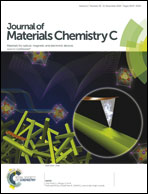The impact of orbital hybridization on the electronic structure of crystalline InGaZnO: a new perspective on the compositional dependence
Abstract
We report an investigation of the electronic structure of crystalline InGaZnO (IGZO) using X-ray absorption spectroscopy (XAS) and ab initio density functional theory calculations. The electronic properties of the conduction band vary significantly with the composition of InGaZnO4 and In2Ga2ZnO7, and this is strongly correlated with the XAS spectra. Detailed analyses of the orbital character reveal crystal field splitting under characteristic local structural distortions of the ZnO5 coordinate bonds, which breaks the In p/d orbital degeneracy and preferentially lowers the energies of the In pz and d(3z2 − r2, xz/yz) orbitals near the Zn ions. The In s–p/d orbitals hybridize and contribute to the low-energy features of the In 5s orbitals. Therefore, the strong dependence of the electronic structure on the composition can be understood in terms of the abundance of distorted ZnO5 coordination near the In3+ ions. In the case of amorphous IGZO, however, the XAS study and the ab initio calculations consistently show that the dependence of the electronic structure on the composition is significantly weaker than it is for crystalline IGZO, which is due to the lack of distinct symmetry in the s–p/d mixed orbitals. This work demonstrates that orbital hybridization is significant in determining the detailed low-energy electronic structure of crystalline IGZO.



 Please wait while we load your content...
Please wait while we load your content...